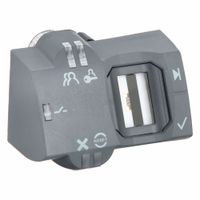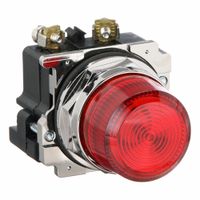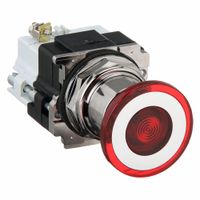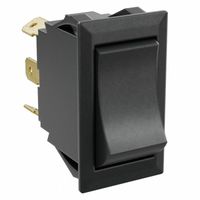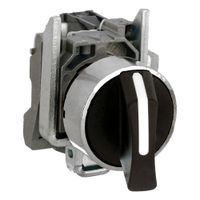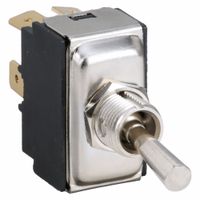Call +(254) 703 030 000 / 751 483 999 / 721 704 777
- Home
- Electrical
- Industrial Controls Automation And Machine Safety
- Operator Switches Pilot Lights
.....Read More
Frequently Asked Questions
What are the different types of operator switches used in industrial equipment?
1. **Toggle Switches**: Commonly used for simple on/off operations, toggle switches are manually operated by a lever or handle. They are often used in control panels for machinery.
2. **Push Button Switches**: These switches are activated by pressing a button. They can be momentary (return to their original position when released) or maintained (stay in position until pressed again). They are used for start/stop functions.
3. **Rotary Switches**: Operated by rotating a knob, these switches can control multiple circuits and are used for selecting different operational modes or settings.
4. **Selector Switches**: Similar to rotary switches, selector switches allow the user to choose between different options or settings. They are often used in control panels for mode selection.
5. **Limit Switches**: These are used to detect the presence or absence of an object, or to determine if a machine has reached a certain position. They are often used for safety and control in automated systems.
6. **Proximity Switches**: These non-contact switches detect the presence of an object within a certain range. They are used in applications where physical contact is not feasible.
7. **Foot Switches**: Operated by foot, these switches allow hands-free operation of machinery, often used in industrial environments where manual operation is impractical.
8. **Joystick Switches**: Used for multidirectional control, joystick switches are often found in equipment that requires complex maneuvering, such as cranes or robotic arms.
9. **Key Switches**: These switches require a key to operate, providing an additional layer of security. They are used in applications where unauthorized operation needs to be prevented.
10. **Rocker Switches**: Similar to toggle switches but with a rocking mechanism, these are used for simple on/off functions and are often found in equipment panels.
11. **Slide Switches**: Operated by sliding a button, these switches are used for simple on/off functions or to select between different settings.
How do biometric switches enhance security in industrial systems?
Biometric switches enhance security in industrial systems by leveraging unique physiological or behavioral characteristics for authentication, thereby reducing the risk of unauthorized access. Unlike traditional security measures such as passwords or keycards, biometric data is difficult to replicate or steal, providing a higher level of security.
These switches use various biometric modalities like fingerprints, facial recognition, iris scans, or voice recognition to verify the identity of individuals accessing sensitive areas or systems. This ensures that only authorized personnel can operate machinery, access control systems, or enter restricted zones, thereby minimizing the risk of sabotage, theft, or accidents caused by unqualified individuals.
Biometric switches also streamline the authentication process, eliminating the need for physical tokens or memorized credentials, which can be lost, stolen, or forgotten. This not only enhances security but also improves operational efficiency by reducing downtime associated with credential management.
Furthermore, biometric systems can be integrated with existing security infrastructure, providing a multi-layered security approach. They can log access attempts, creating an audit trail that can be used for monitoring and forensic analysis in case of security breaches. This capability aids in compliance with industry regulations and standards, ensuring that security protocols are consistently enforced.
In addition, biometric switches can be configured to trigger alerts or lockdowns in response to unauthorized access attempts, providing real-time security responses. This proactive approach helps in mitigating potential threats before they escalate.
Overall, biometric switches offer a robust, efficient, and user-friendly solution for enhancing security in industrial systems, protecting critical assets, and ensuring the safety of personnel and operations.
What are the advantages of using joystick operator switches in machinery?
Joystick operator switches offer several advantages in machinery operation:
1. **Precision Control**: Joysticks provide precise control over machinery movements, allowing operators to make fine adjustments easily. This is particularly beneficial in applications requiring high accuracy, such as in robotics or CNC machines.
2. **Multi-Directional Input**: Unlike traditional switches, joysticks can handle multi-directional input, enabling complex maneuvers and operations with a single control device. This reduces the need for multiple switches and simplifies the control panel.
3. **Ergonomic Design**: Joysticks are designed to be ergonomic, reducing operator fatigue during prolonged use. Their intuitive design allows for natural hand movements, which can enhance comfort and efficiency.
4. **Space Efficiency**: By consolidating multiple control functions into a single device, joysticks save space on control panels. This is advantageous in environments where space is limited.
5. **Versatility**: Joysticks can be used in a wide range of applications, from heavy machinery to video game controllers, making them a versatile choice for various industries.
6. **Durability**: Many joysticks are built to withstand harsh environments and heavy use, ensuring long-term reliability and reducing maintenance costs.
7. **Enhanced Safety**: Joysticks can be equipped with features like dead-man switches, which enhance safety by requiring constant pressure to operate, preventing accidental activation.
8. **User-Friendly**: The intuitive nature of joystick controls makes them easy to learn and use, reducing training time for new operators.
9. **Customization**: Joysticks can be customized with different grips, buttons, and configurations to suit specific operational needs, providing flexibility in design and functionality.
10. **Feedback Mechanisms**: Some joysticks offer haptic feedback, providing tactile responses to the operator, which can improve control and awareness during operation.
How do push buttons function in controlling circuits?
Push buttons function as simple switches in controlling circuits. When pressed, they complete an electrical circuit, allowing current to flow and activating a connected device or system. Push buttons typically consist of a spring-loaded mechanism that returns to its original position when released, breaking the circuit and stopping the current flow.
In a normally open (NO) configuration, the circuit is incomplete until the button is pressed. This is commonly used for momentary actions, such as ringing a doorbell or starting a machine. Conversely, a normally closed (NC) configuration keeps the circuit complete until the button is pressed, interrupting the current flow. This setup is often used for emergency stop functions.
Push buttons can be integrated into more complex systems using relays or logic circuits. When a button is pressed, it can trigger a relay, which then controls a larger current or multiple circuits. This allows for the control of high-power devices with a low-power button press.
In digital circuits, push buttons can be used to send signals to microcontrollers or processors. The button press generates a voltage change, which is detected by the microcontroller, triggering a programmed response. Debouncing techniques are often employed to ensure that only a single signal is registered per press, as mechanical contacts can create multiple signals due to vibrations.
Overall, push buttons are versatile components in controlling circuits, providing a simple and effective means of user interaction with electronic systems.
What is the difference between rocker switches and toggle switches?
Rocker switches and toggle switches are both types of electrical switches used to control the flow of electricity in a circuit, but they differ in design, operation, and application.
Rocker switches have a flat, rectangular or rounded surface that rocks back and forth to open or close a circuit. When pressed on one side, the opposite side raises, allowing for easy operation with a simple push. They are often used in household appliances, power strips, and automotive applications due to their modern appearance and ease of use. Rocker switches are typically more aesthetically pleasing and can be designed to blend seamlessly with the surface they are mounted on.
Toggle switches, on the other hand, have a lever or handle that moves up and down or side to side to open or close a circuit. The lever is usually more pronounced, making it easier to operate in situations where tactile feedback is important, such as in industrial settings or on control panels. Toggle switches are known for their durability and reliability, often used in environments where they may be subject to frequent use or harsh conditions.
In terms of installation, rocker switches are generally flush-mounted, providing a cleaner look, while toggle switches protrude from the mounting surface, making them more accessible in certain applications. Both types of switches can be found in various configurations, including single-pole, double-pole, and multi-position, to suit different electrical needs.
Overall, the choice between rocker and toggle switches depends on factors such as aesthetic preference, ease of use, and the specific requirements of the application.
How do pilot and indicator lights work in signaling equipment status?
Pilot and indicator lights are essential components in signaling equipment status, providing visual cues about the operational state of machinery or systems. These lights are typically color-coded to convey specific information quickly and effectively.
Pilot lights are small, often LED-based, lights that indicate the operational status of equipment. They are usually mounted on control panels and are designed to be easily visible. Common colors include red, green, yellow, blue, and white, each representing different states. For instance, a green light typically indicates normal operation or that a system is active, while a red light often signals a fault or that the equipment is off. Yellow or amber lights usually warn of caution or standby status, and blue or white lights might indicate specific functions or modes.
Indicator lights function similarly but are often used to show the status of specific components or processes within a system. They can be integrated into switches, buttons, or other control devices. These lights help operators quickly assess the condition of equipment without needing to interpret complex data or read detailed displays.
Both pilot and indicator lights work by completing an electrical circuit that illuminates the light when a particular condition is met. This can be controlled by sensors, switches, or automated systems that detect changes in the equipment's status. The simplicity and reliability of these lights make them invaluable in industrial, commercial, and consumer applications, ensuring that operators can maintain safety and efficiency by responding promptly to the visual signals provided.
What are the roles of contact blocks and lamp modules in operator switches?
Contact blocks and lamp modules are essential components in operator switches, each serving distinct roles to ensure effective operation and communication in control systems.
Contact Blocks:
1. **Electrical Connection**: Contact blocks are responsible for making or breaking electrical connections when the operator switch is actuated. They are the core components that control the flow of electricity to various parts of a system.
2. **Signal Transmission**: They transmit signals to other devices or systems, initiating or halting operations based on the switch's position.
3. **Configuration Flexibility**: Contact blocks can be configured in various ways, such as normally open (NO) or normally closed (NC), to suit specific operational requirements.
4. **Safety and Reliability**: They ensure safe and reliable operation by providing a robust mechanism for controlling electrical circuits, often incorporating features to prevent accidental activation or deactivation.
5. **Modularity**: Contact blocks are often modular, allowing for easy replacement or addition of contacts to accommodate changes in system requirements.
Lamp Modules:
1. **Visual Indication**: Lamp modules provide visual feedback on the status of the operator switch, indicating whether a circuit is active or inactive.
2. **Status Communication**: They communicate the operational status to users, enhancing safety and efficiency by allowing quick identification of system states.
3. **Color Coding**: Different colors can be used to represent various states or conditions, aiding in quick recognition and response.
4. **Energy Efficiency**: Modern lamp modules often use LEDs, which are energy-efficient and have a long lifespan, reducing maintenance needs.
5. **Integration**: Lamp modules are integrated into the switch assembly, ensuring a compact design and easy installation.
Together, contact blocks and lamp modules enable operator switches to perform their functions effectively, providing control, feedback, and safety in industrial and commercial applications.
